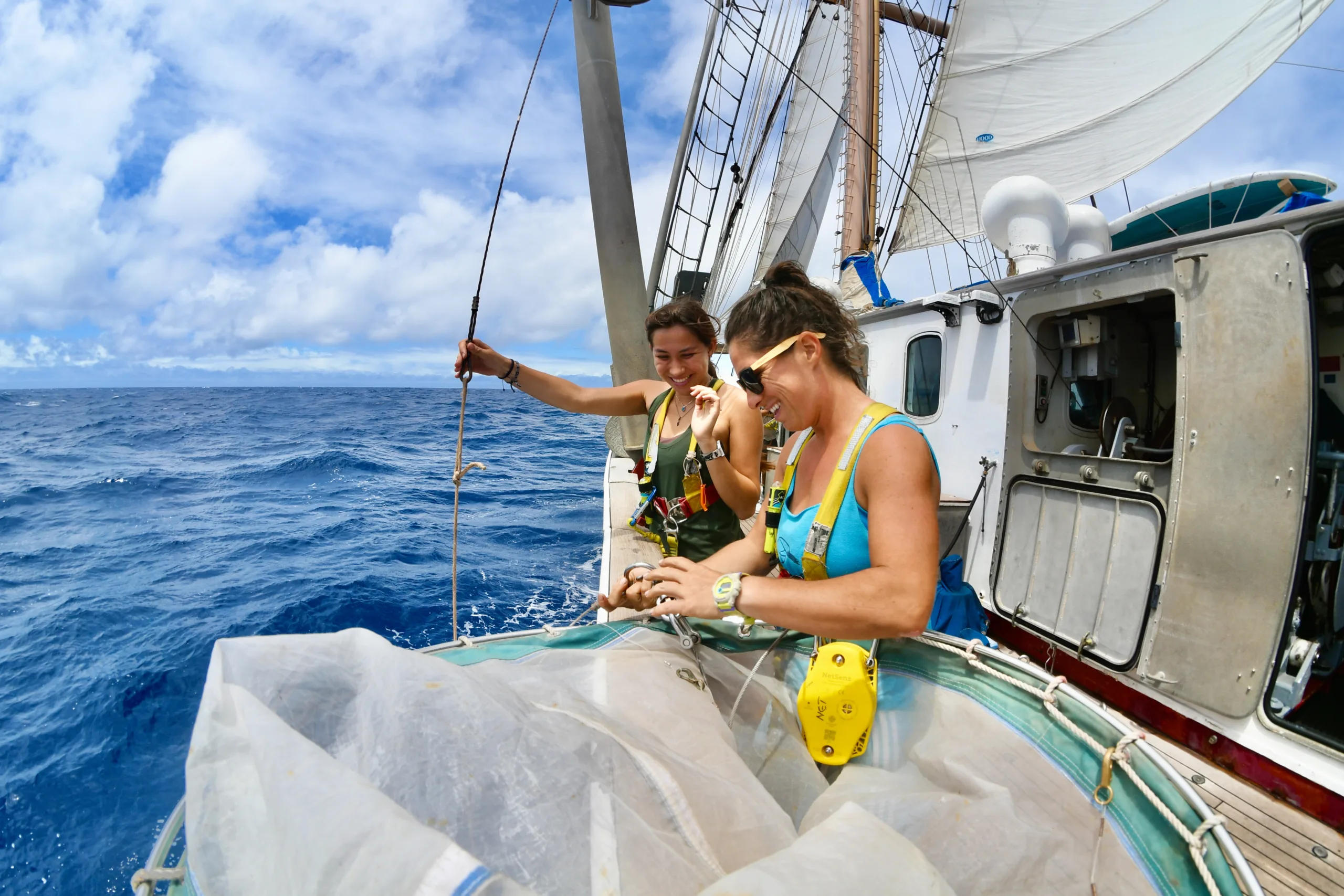Programs Blog
Sciencing at Sea

July 6, 2025
Time: 1530
Location: 10˚30’N, 950 NM South of Oahu
Weather: Cloudy with a chance of MeatSqualls
Hello hello blog readers!
While I’m sure you are getting familiar with the faces of A, B, and C watches, I’m here to introduce the final group of sailors: the Others. This group consists of Captain Allison, the stewards (Vix and Gillian), the professors (Jan and Beth), the engineers (Angie and Leyla), and the BNA lab hands (Brian aNd Audrey—or Blue Nature Alliance depending on who you ask). Brian and I are visiting scientists onboard through the Blue Nature Alliance and Rotjan Lab back in Boston University, meaning that we assist with all science deployments and data processing onboard!
A typical day, like today, consists of three deployments that occur around 0930 and 2130 every day. I’m on daytime deployment shift this week which is why I can write this blog entry while the sun is still out. For my day today, I woke up at 0600 with the oncoming A-watch and the Others, enjoying a hefty bowl of cereal and sliced apples with sunbutter for breakfast. Following this is a bunch of science-deck-set-up (preparing the nets and hydrocast, putting out taglines, turning on the machinery, and setting up the data sheets), which was done with Flo and Isaiah from A-watch, and Jordan (the ship’s 1st Marine Tech). After all the prep, it’s usually time for chores at 0730, which means I can get a coffee afterwards as a reward (and because I’ve turned into a caffeine-fiend onboard…). With time to spare between chores and deployment, I can either squeeze a nap in, journal, or read—which is what I opted for today, starting a new book: “Dune.” As it gets closer to deployment time, we’ll prepare the sails, gybe to turn the boat around, and come to a stop to begin sciencing.
The hydrocast is first to go in, collecting data on chlorophyll, salinity, and temperature from depths down to 600 meters. Following that is the meter net (my personal favorite since it usually brings up cool critters), which requires us to get the boat up to speed at 2 knots in order to deploy. This net goes down to around 250 meters, while the final net, the neuston tow, dwells at the surface. Both of these nets have a cod-end jar on the back that collects everything entering them, and after emptying their contents out, I’ll pick through the samples with my favorite pair of tweezers (the longer ones with the rounded ends—not a big fan of the sharp ones and NEVER the square ended ones). Some tows will collect a mere 2 mL of plankton, with others bio-voluming up to the hundreds.
For each sample, I’ll pick through and collect specific organisms—like larval fish, cephalopods, and leptocephali—tally up their numbers, biovolume them, and jar them in little vials of ethanol. In other words, I have first dibs on seeing what creatures are currently dwelling below and around the ship—my favorites being the snipe eels and viperfish we found around the equator during night deployments. After all the measuring and sorting, I’ll get a 1 mL scoop from each tow for the students’ 100 counts (where they quite literally count the first hundred creatures that they see), fill out the data sheets, and label all the zooplankton jars/vials. With that, my “work” day is complete. So what else do I do…
I finished around 1330 today, and if it’s sunny outside (or I’m starting to smell bad), I’ll usually take a deck shower, lay out on top of the ship to journal or draw, learn card games, and take photos of the ocean and fellow sailors. It’s raining currently, to my dismay, meaning I’m writing this blog in the library instead of bothering the watch group on deck.
Before dinner, I usually soak in the sunsets and wait for the elusive green flash (though the clouds tend to obscure the sun), and afterwards, I try to learn about various constellations. However, with the frequency of rain these last few days, I haven’t been able to get my fill of shooting stars. Regardless of if I end the day seeing Scorpio and making up constellations (though they have all started to look like various zooplanktons), I’m constantly thankful for the fantastic food and friends onboard that make each day brighter, rain or shine. What else could I wish for?
Sending extra love to the fam (happy belated birthdays Mar and Arlo)!! <3
Audrey Jackson, Others
Boston University

Recent Posts from the Ships
- Ocean Classroom 2024-A collaborative high school program with Proctor Academy
- Collaborations and Long-term Commitments: SEA’s Caribbean Reef Program Sets a Course for Coastal Programs that Compliment Shipboard Experiences.
- Sea Education Association students prepare for life underway using state of the art nautical simulation from Wartsila Corporation.
- SEA Writer 2022, Magazines From the Summer SEA Quest Students
- Technology@SEA: Upgrades Allow Insight into Ocean Depths
Programs
- Gap Year
- Ocean Exploration
- High School
- Science at SEA
- SEA Expedition
- SEAScape
- Pre-College
- Proctor Ocean Classroom
- Protecting the Phoenix Islands
- SPICE
- Stanford@SEA
- Undergraduate
- Climate and Society
- Climate Change and Coastal Resilience
- Coral Reef Conservation
- Marine Biodiversity and Conservation
- MBL
- Ocean Exploration: Plastics
- Ocean Policy: Marine Protected Areas
- Oceans and Climate
- Pacific Reef Expedition
- The Global Ocean: Hawai'i
- The Global Ocean: New Zealand